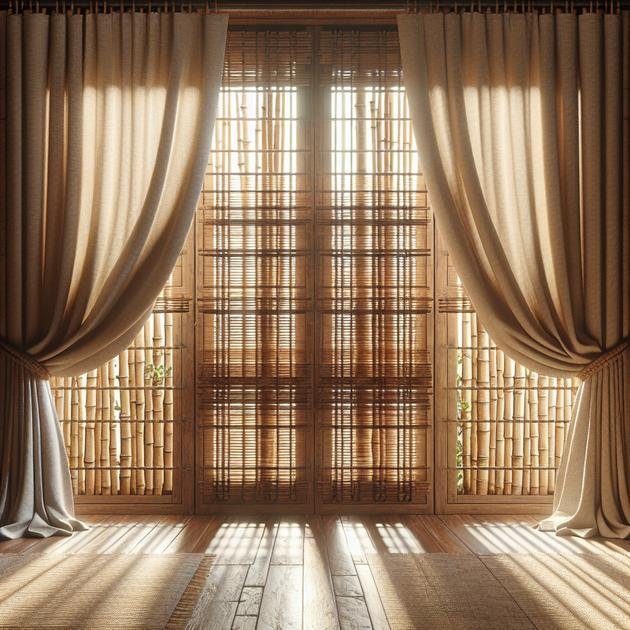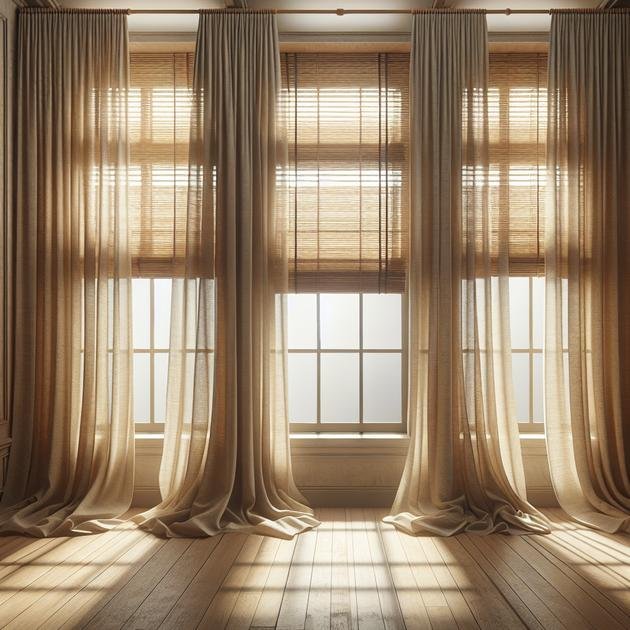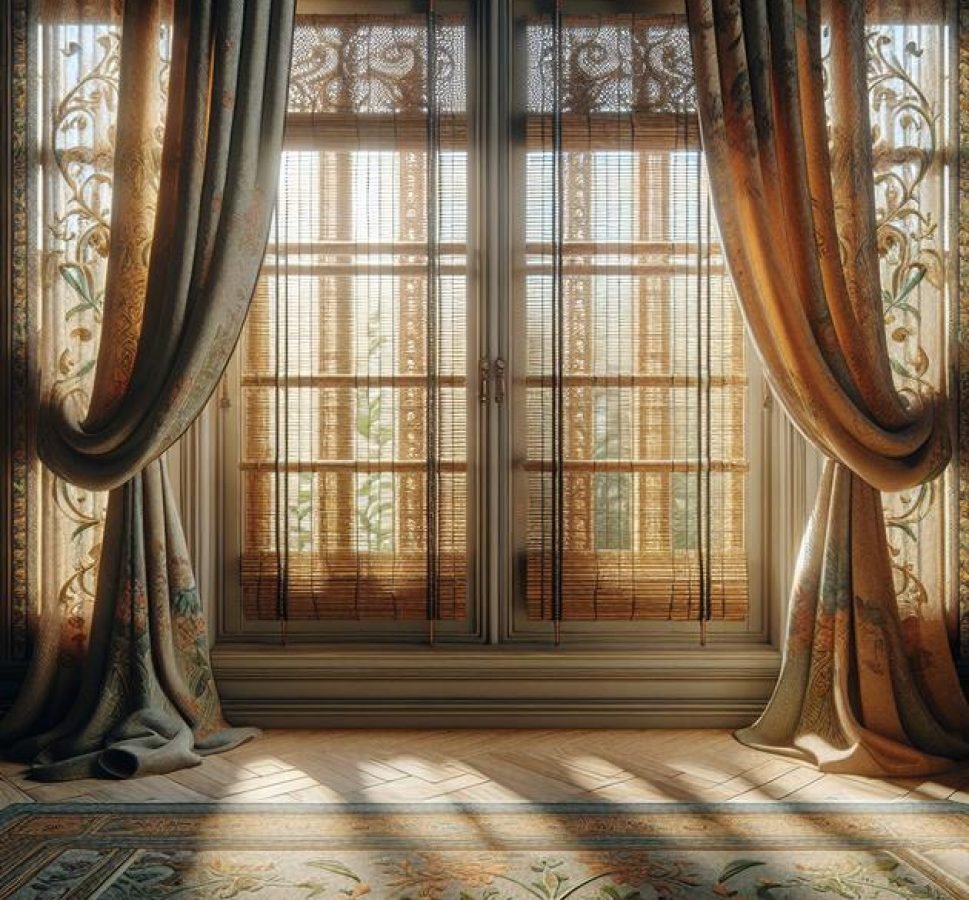Sustainable window treatments use eco-friendly materials like bamboo, organic cotton, and recycled fabrics to improve energy efficiency, indoor air quality, and style while reducing environmental impact and supporting health.
Sustainable window treatments can change the way your home looks and feels, bringing in style that’s gentle on the planet. Ever wondered how to pick the right eco-friendly blinds or curtains that don’t just save energy but also elevate your space? Let’s dive into ideas that might surprise you.
why sustainable window treatments matter
Sustainable window treatments matter because they reduce your home’s environmental impact while enhancing comfort and style. Traditional window coverings often use synthetic materials that are hard to recycle and require energy-intensive production. In contrast, eco-friendly options use natural fibers like bamboo, cotton, or recycled materials that minimize waste and pollution.
These treatments also help improve energy efficiency by providing better insulation and blocking harsh sunlight, which lowers heating and cooling costs. This not only reduces your carbon footprint but also saves money over time.
Health and Environmental Benefits
Using sustainable materials lowers exposure to harmful chemicals commonly found in conventional window treatments. This can improve indoor air quality and overall well-being.
Choosing sustainable options supports responsible manufacturing practices and encourages brands to be more transparent and eco-conscious, creating a positive cycle that benefits the planet and communities.
Style Without Compromise
Many assume sustainable means boring, but modern designs offer a wide variety of colors, textures, and styles that fit any décor. Sustainable window treatments prove you can have beauty, comfort, and care for the environment all in one package.
types of eco-friendly window coverings
There are several types of eco-friendly window coverings that combine sustainability with style. Some popular options include bamboo shades, made from fast-growing bamboo, which is a renewable resource. These shades are durable and provide a natural look.
Another option is organic cotton curtains, which use cotton grown without harmful pesticides. These curtains are soft, breathable, and biodegradable. Linen is also a good choice, as it is made from flax plants and requires less water and chemicals to produce compared to cotton.
Recycled Materials
Window coverings made from recycled fabrics or plastics reduce landfill waste. For example, some brands offer shades made from recycled PET bottles, which are durable and water-resistant.
Natural Fibers and Materials
Woven wood shades, made from grasses, reeds, and bark, bring texture and warmth while being biodegradable. Cork blinds are emerging as sustainable options too, thanks to cork’s rapid renewability and insulating properties.
Eco-friendly window coverings come in many styles, including roller shades, Roman shades, curtains, and blinds, allowing you to choose the perfect fit for your home.
benefits of using natural materials
Natural materials offer several benefits when used for window treatments. They are renewable, biodegradable, and often produced with fewer chemicals compared to synthetic options. This means they have a smaller environmental footprint from production to disposal.
Durability and Comfort
Many natural materials such as cotton, linen, and bamboo are not only durable but also provide a soft, warm texture that enhances your home’s comfort. These materials also improve indoor air quality by avoiding harmful volatile organic compounds (VOCs) found in some synthetic fabrics.
Energy Efficiency
Curtains and shades made from natural fibers can provide excellent insulation. They help retain heat in the winter and block heat in the summer, reducing your home’s energy use and lowering utility bills.
Aesthetic Appeal
The unique textures and colors of natural materials create a timeless look that adapts well to various interior styles. They often age gracefully and can be easier to maintain and repair.
Choosing natural materials for your window treatments means investing in health, sustainability, and lasting beauty.
how to choose the right sustainable window treatment

Choosing the right sustainable window treatment involves considering several important factors. First, think about your energy efficiency needs. Look for treatments that provide good insulation to keep your home warm in winter and cool in summer.
Material Selection
Opt for natural, renewable materials like bamboo, organic cotton, or recycled fabrics. These options are eco-friendly and tend to be safer for indoor air quality since they avoid harmful chemicals.
Style and Functionality
Consider the design and functionality you want. Do you prefer curtains, shades, or blinds? Each type serves different purposes such as blocking light, providing privacy, or enhancing aesthetics.
Sizing and Measurement
Accurate measurements are crucial to ensure your window treatments fit perfectly and function well. Many eco-friendly brands offer custom sizing options to reduce waste.
Maintenance and Durability
Look for treatments that are easy to clean and maintain. Durable materials will last longer, reducing the need for replacement and further waste.
Checking certifications like Greenguard or OEKO-TEX can guide you to sustainable and safe choices. Finally, balance sustainability with your style and comfort preferences to find the perfect fit for your home.
energy efficiency and cost savings
Energy efficiency is one of the biggest benefits of sustainable window treatments. They help regulate indoor temperatures by providing insulation that keeps cold air out during winter and blocks heat in the summer. This means your heating and cooling systems don’t have to work as hard, reducing energy consumption.
How Window Treatments Save Money
Reducing energy use directly lowers your utility bills. Properly installed eco-friendly blinds, shades, or curtains can save homeowners up to 15% on heating and cooling costs annually.
Materials and Design Matter
Natural fibers like bamboo and organic cotton not only enhance insulation but also allow breathability, preventing moisture buildup. Some window treatments come with reflective coatings or are layered to maximize thermal efficiency.
Additional Benefits
Besides saving energy, these treatments can reduce glare, protect furniture from UV damage, and increase overall comfort. Using sustainable materials also means supporting products that are less harmful to the environment.
Investing in sustainable window treatments creates a win-win situation: lower energy bills and a greener, healthier home.
impact on indoor air quality
Indoor air quality can be significantly improved by choosing the right sustainable window treatments. Many traditional window coverings contain synthetic materials that emit volatile organic compounds (VOCs), which can harm your health over time.
Benefits of Natural Fibers
Natural materials like organic cotton, linen, and bamboo do not release harmful chemicals. They also resist dust and allergens better, contributing to a cleaner indoor environment.
Reducing Chemical Exposure
Selecting treatments with low or zero VOC emissions helps reduce airborne toxins, making your home safer, especially for children, seniors, and those with respiratory issues.
Breathability and Moisture Control
Natural fabrics allow better airflow and moisture absorption, which helps prevent mold and mildew growth around windows. This is crucial for maintaining healthier air.
By investing in eco-friendly window coverings, you promote fresher air indoors while supporting materials that are kinder to the planet and your health.
trends in sustainable window designs
Modern trends in sustainable window designs focus on combining eco-friendliness with aesthetics and smart technology. Natural materials like bamboo, cork, and organic cotton are being used more widely, reflecting a shift towards greener choices in home décor.
Smart and Eco-friendly Integration
Many sustainable window treatments now include smart features such as automated blinds controlled by apps or timers. These systems improve energy efficiency by adjusting light and temperature throughout the day.
Minimalist and Natural Aesthetics
Designs emphasize simplicity and texture, showcasing raw materials instead of synthetic finishes. Neutral color palettes inspired by nature, such as earth tones and soft greens, remain popular.
Customization and Upcycling
Upcycled fabrics and customizable window treatments that fit specific window sizes reduce waste and promote personalization. Consumers increasingly prefer products with a story and a clear environmental benefit.
These trends highlight a move toward homes that are not only beautiful but also mindful of environmental impact and health.
maintaining and cleaning eco-friendly treatments

Maintaining and cleaning eco-friendly window treatments properly can extend their life and preserve their appearance. Many natural materials require gentle care to avoid damage and keep them looking fresh.
Regular Dusting
Use a soft cloth, vacuum with a brush attachment, or a feather duster to remove dust regularly. This prevents buildup that can degrade the fibers or fabrics over time.
Spot Cleaning
For minor stains, blot the area gently with a damp cloth and mild, eco-friendly detergent. Avoid harsh chemicals and excessive water, which can harm natural fibers like cotton or bamboo.
Deep Cleaning
Some treatments, like cotton curtains, can be machine washed on a gentle cycle using eco-friendly detergents. Always check care labels before cleaning. Bamboo and woven wood shades may need professional cleaning.
Avoiding Damage
Keep window treatments out of direct sunlight when possible to prevent fading. Also, avoid excessive moisture that can cause mold or mildew to grow on natural fabrics.
Proper maintenance helps you enjoy beautiful, sustainable window treatments that last for years while reducing the need for replacements.
where to buy sustainable window coverings
When looking to buy sustainable window coverings, it’s important to find retailers that specialize in eco-friendly, high-quality products. Many stores and online platforms now offer a wide range of options made from natural, recycled, or renewable materials.
Specialty Eco-Friendly Stores
Look for stores that focus exclusively on sustainable home décor. These retailers carefully select products that meet strict environmental standards and often provide detailed information about materials and manufacturing processes.
Major Online Retailers
Large e-commerce platforms increasingly feature sustainable window treatments. Read product descriptions and customer reviews to ensure you’re choosing treatments made with certified eco-friendly materials.
Local Artisan Markets
Supporting local artisans who create handcrafted, sustainable window coverings can reduce your carbon footprint and promote community businesses. These products often use organic materials and unique designs.
Certification and Labels
Check for certifications like Greenguard, OEKO-TEX, or FSC. These labels verify that products meet environmental and safety criteria.
Finding the right place to purchase sustainable window treatments means balancing quality, environmental impact, and price to best suit your home’s needs.
combining style and sustainability
Combining style and sustainability in window treatments is easier than ever. Modern designs offer eco-friendly materials without sacrificing aesthetic appeal. Natural fibers like linen, cotton, and bamboo bring warmth, texture, and elegance to any space.
Color and Texture Choices
Sustainable window coverings come in a variety of colors and textures, from soft neutrals to bold patterns. This variety allows you to match your décor while supporting eco-conscious choices.
Designs That Fit Any Home
Whether your style is minimalist, rustic, or contemporary, there are sustainable options to suit it. Roman shades, roller blinds, and curtains can all be made with sustainable materials.
Custom and Versatile Options
Custom sizing and design help reduce waste by ensuring a perfect fit, while versatile treatments can be combined or layered for unique looks and improved energy efficiency.
By choosing sustainable window treatments, you get the best of both worlds: style that complements your home and care for the planet.
case studies of sustainable window projects
Sustainable window treatment projects showcase practical uses of eco-friendly materials and innovative designs that save energy and reduce environmental impact. For example, a residential project in California used bamboo blinds and organic cotton curtains to lower cooling costs by improving natural ventilation.
Commercial Green Building
A commercial office building in New York installed recycled fabric roller shades combined with smart automated systems. This helped reduce energy consumption by adjusting light exposure according to the time of day.
Historic Home Restoration
In a historic home renovation in Vermont, reclaimed wood blinds and natural linen curtains were used to preserve character while enhancing insulation and aesthetics.
Case studies of sustainable window projects highlight the versatility and benefits of eco-friendly window treatments across different settings, demonstrating real-world applications of sustainability principles.
potential challenges and how to overcome them

Choosing and installing sustainable window treatments can come with challenges, but knowing how to handle them helps you make the most of your investment.
Material Availability and Cost
Eco-friendly materials may be less common or more expensive than traditional options. To overcome this, research suppliers thoroughly and consider DIY projects using recycled or upcycled fabrics to save costs.
Durability Concerns
Some natural materials may wear out faster if not cared for properly. Regular maintenance with gentle cleaning methods and avoiding direct exposure to harsh sunlight will extend the life of treatments.
Limited Style Options
Although options are growing, some sustainable designs may not match every décor style. Customizing window treatments or combining materials can create unique looks that suit your home.
Installation Challenges
Eco-friendly blinds or shades might differ in installation compared to conventional ones. Hiring professionals familiar with these products ensures proper setup and functionality.
By addressing these challenges with good planning and care, sustainable window treatments can provide beauty, comfort, and eco-friendliness for years.
DIY ideas for sustainable window treatments
DIY sustainable window treatments are a creative and eco-friendly way to refresh your space. Using recycled or natural materials, you can make blinds, curtains, or shades that are both stylish and sustainable.
Recycled Fabric Curtains
Use old clothing or fabric scraps to sew new curtains. Organic cotton or linen fabrics are great for a natural look and feel. This reduces waste and adds a personal touch to your windows.
Bamboo or Wood Blinds
Bamboo sticks or reclaimed wood can be crafted into simple blinds. With minimal tools and some patience, you can create durable blinds that bring warmth and texture to your room.
Macramé Shades
Macramé, made from natural cotton or hemp ropes, offers a boho-inspired design that is both trendy and sustainable. These shades allow light to filter through while adding artistic flair.
Natural Dye and Paint
Give plain curtains a unique look by dyeing them with natural plant-based dyes or painting eco-friendly patterns. This enhances sustainability by avoiding synthetic chemicals.
Embracing DIY projects for window treatments lets you express your creativity while protecting the planet with sustainable materials.
recycling and disposal options
Recycling and disposal options for sustainable window treatments are important to minimize environmental impact once they reach the end of their life cycle. Many natural materials used in eco-friendly treatments are biodegradable, which means they break down safely without polluting the environment.
Recycling Programs
Some manufacturers and retailers offer take-back or recycling programs where you can return old window treatments for proper recycling or repurposing. This helps reduce landfill waste and supports circular economy principles.
Composting Natural Materials
Window coverings made from organic fibers like cotton, linen, or bamboo can often be composted if separated from synthetic components. Composting returns nutrients to the soil and reduces waste.
Donation and Upcycling
If the treatments are still in good condition, consider donating them to charities, schools, or community centers. Upcycling old fabrics and blinds into new household items or crafts is another creative disposal method.
Proper disposal ensures that your sustainable window treatments continue to benefit the environment long after use, keeping waste out of landfills and promoting responsible resource use.
future innovations in sustainable window design
Future innovations in sustainable window design promise to blend technology, ecology, and style like never before. Smart window treatments will use sensors and automation to optimize natural light and indoor temperatures, reducing energy use even further.
Advanced Materials
Researchers are developing new eco-friendly materials that are stronger, lighter, and more durable. These include bio-based fabrics and coatings that can reflect heat or filter UV rays without harmful chemicals.
Energy Harvesting Windows
Some designs incorporate solar cells into window treatments, allowing them to generate renewable energy while controlling light and privacy.
Modular and Adaptive Designs
Future sustainable window coverings may come as modular units that adapt to changing weather or user preferences, increasing usability and lifespan.
These innovations point to a future where sustainable window treatments not only protect the environment but actively contribute to smarter, healthier homes.
Embracing Sustainable Window Treatments for a Better Home
Choosing sustainable window treatments is a smart way to improve your home’s energy efficiency, air quality, and style while caring for the planet. From natural materials to innovative designs, there are many options to fit your needs and taste.
By understanding the benefits and how to maintain and select the right treatments, you can make informed decisions that save money and reduce environmental impact. As technology evolves, sustainable window designs will continue to offer more benefits and opportunities for a greener lifestyle.
Start exploring these eco-friendly options today and create a comfortable, beautiful, and sustainable home for years to come.





